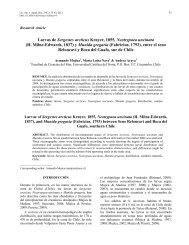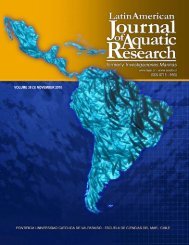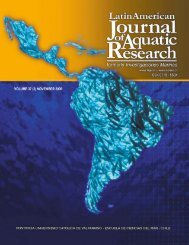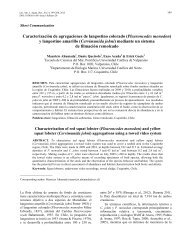Portada LAJAR-2013 (1).psd - Latin American Journal of Aquatic ...
Portada LAJAR-2013 (1).psd - Latin American Journal of Aquatic ...
Portada LAJAR-2013 (1).psd - Latin American Journal of Aquatic ...
You also want an ePaper? Increase the reach of your titles
YUMPU automatically turns print PDFs into web optimized ePapers that Google loves.
sorting. To estimate biomass, species were pooled by<br />
taxonomic group and weighted (wet weight) with an<br />
analytical balance (0.001 g).<br />
Data analysis<br />
Density and biomass are expressed, respectively, in<br />
mean number <strong>of</strong> individuals and in g m -2 . Species<br />
richness (S), Shannon-Weaver diversity (He’) and<br />
evenness (J’) indexes were also calculated. Natural<br />
logarithm was used for calculating diversity in order<br />
to compare present data with those <strong>of</strong> previous works<br />
carried out in the adjacent continental shelf (such as<br />
Pires-Vanin, 1993, 2008). Species abundance data<br />
were pooled in three groups <strong>of</strong> stations, as reported in<br />
Arasaki et al. (2004) for São Sebastião Channel<br />
(SSC). According to these authors the bottom <strong>of</strong> the<br />
SSC may be divided in three different areas based on<br />
granulometry and sedimentary organic matter content:<br />
central area with muddy sediment and high levels <strong>of</strong><br />
total organic matter (Group I); south and north areas<br />
characterized by mixed sediments and medium values<br />
<strong>of</strong> organic matter (Group II); coarse sandy area with<br />
low organic matter content situated along the São<br />
Sebastião Island side (Group III).<br />
In the present paper, stations 2, 7, and 10<br />
correspond to Group I, stations 1, 4, 5, 6 and 12 to<br />
Group II, and stations 3, 9, 11, 13, 14 and 15 to Group<br />
III. The ANOVA analysis was employed for testing<br />
differences <strong>of</strong> the biological parameters among the<br />
four cruises. Multiple Linear Regression models were<br />
used for identifying the relationships between<br />
biological and environmental variables (BioEstat 5.0,<br />
Ayres et al., 2007), considering the significance level<br />
<strong>of</strong> 0.05.<br />
Macr<strong>of</strong>auna <strong>of</strong> São Sebastião Channel, Southeastern Brazil<br />
Station Depth S T O 2 O 2 MS FS Silt Clay C C/N Diam Class<br />
(m) (ºC) (mL L -1 ) (%) (%) (%) (%) (%) (%) (ϕ)<br />
3 10 33.24 20.40 4.92 95.1 7.39 80.14 11.51 0.00 0.43 8.60 3.04 Very fine sand<br />
4 10 33.19 20.39 4.34 83.8 0.28 91.72 4.40 3.3 0.38 7.60 3.48 Very fine sand<br />
5 23 33.16 20.39 4.86 93.8 1.22 86.23 8.86 3.32 0.50 8.33 3.13 Very fine sand<br />
6 10 33.25 20.58 4.78 92.7 5.36 69.51 20.63 2.06 0.69 11.50 3.84 Very fine sand<br />
7 10 33.60 20.71 4.93 95.9 0.21 17.8 58.80 23.1 1.70 14.16 6.15 Fine silt<br />
8 45 33.84 20.68 5.11 99.7 9.63 19.48 39.75 15.46 0.82 11.71 4.52 Coarse silt<br />
9 10 33.39 20.65 5.06 98.3 40.78 36.42 0.27 0.00 0.17 8.50 1.61 Medium sand<br />
10 10 33.29 20.58 5.13 99.4 0.12 31,00 56.32 12.52 1.48 14.80 5.4 Medium silt<br />
11 28 34.22 20.70 4.65 90.8 29.94 10.5 2.51 0,00 0.11 5.50 0.62 Coarse sand<br />
12 9 33.78 20.53 4.73 91.9 17.82 44.5 14.11 4.03 0.52 10.40 2.54 Fine sand<br />
13 11 33.74 20.60 5.15 100.2 8.16 68.82 7.46 1.24 0.51 12.75 2.72 Fine sand<br />
14 26 34.10 20.64 5.12 96.1 26.51 14.28 9.09 3.41 0.3 7.50 1.22 Medium sand<br />
15 8 34.05 20.66 5.16 100.5 32.75 19.94 9.28 5.3 0.41 10.25 1.86 Medium sand<br />
RESULTS<br />
46<br />
The environment<br />
Bottom water showed temperature near or higher than<br />
20ºC along the channel and salinity varied between 31<br />
and 35 psu. A seasonal pattern was detected, with<br />
large variation in spring (16.8 to 23.5ºC for<br />
temperature and 31.4 to 35 psu for salinity) and high<br />
homogeneity in winter (temperatures varying between<br />
20.2 and 20.7ºC and salinities between 33.1 and 33.8<br />
psu) (Table 1). In summer temperature was always<br />
high, reaching 29.85ºC at 15 m depth (station 1). The<br />
deepest station (station 8), located in the central area<br />
<strong>of</strong> the channel, presented the extreme values for both<br />
variables.<br />
Temperature and salinity distributions indicate that<br />
Coastal Water (CW) filled the channel during the<br />
study period, except in spring when the cold and<br />
saline South Atlantic Central Water (SACW) occurred<br />
in the deepest part (station 8).<br />
Oxygen saturation was generally high and values<br />
below 75% were found in few stations, at the south<br />
area <strong>of</strong> the channel, in spring and fall (Table 1).<br />
Sediments showed high heterogeneity along the<br />
channel with deposition <strong>of</strong> finer sands in the south<br />
entrance and coarse grains both in the north and<br />
insular side. The continental side and central area were<br />
dominated by pelitic fractions (silt and clay)<br />
associated with high values <strong>of</strong> organic carbon and<br />
nitrogen.<br />
The highest values <strong>of</strong> organic carbon and total<br />
nitrogen were frequently found at stations 2, 7 and 10.<br />
Results <strong>of</strong> C/N ratio indicated the predominance <strong>of</strong><br />
organic matter <strong>of</strong> marine origin at stations 1 and 11,<br />
during the four samplings, and also in the whole axis







